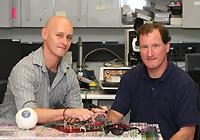Bionic vision
A prototype bionic eye developed at UNSW could be ready for human trials by 2012 following the announcement of a national research collaboration.
A prototype bionic eye developed at UNSW could be ready for human trials by 2012 following the announcement of a national research collaboration.

Life-changing bionic vision is a step closer following the announcement this week of a new partnership between UNSW and other world-leading Australian research institutes to fast-track development of a bionic eye.
The new consortium, Bionic Vision Australia, combines the research expertise of UNSW's Centre for Implantable Bionics and Australian Vision Prosthesis Group, the University of Melbourne, The Bionic Ear Institute, the Centre for Eye Research Australia and the Victoria Research Laboratory of NICTA.
Bionic Vision Australia will pursue the development of the most technologically advanced bionic eye to improve the sight of people with degenerative or inherited retinal disease. Retinal cell degeneration is a major cause of the severe vision loss suffered by more than 50,000 Australians at present.
Bionic Vision Australia Chairman, Emeritus Professor David Penington AC, said the new partnership "brings together Australia's international experts in medical bionics, covering the many disciplines required to develop a safe and technologically advanced device able to restore functional vision".
"Our team is well placed to undertake the critical research required to deliver an advanced bionic eye, which would deliver improved quality of life for patients suffering from common causes of severe loss of vision and blindness," he said.
Centre for Implantable Bionics co-director, Associate Professor Gregg Suaning, said a first prototype bionic eye, developed at UNSW, could be ready for human implantation by 2012. An enhanced second prototype, developed at the Victoria Research Laboratory of NICTA, could be ready for the first human implantation by late 2013.
Bionic Vision Australia has submitted a detailed plan and funding request to the Federal Government to enable it to undertake the required research and early clinical testing. The New South Wales and Victorian governments have both provided support to the partnership to enable the development of the detailed plan.
Media Contact: Peter Trute, UNSW Media Office | 02 9385 1933 | p.trute@unsw.edu.au